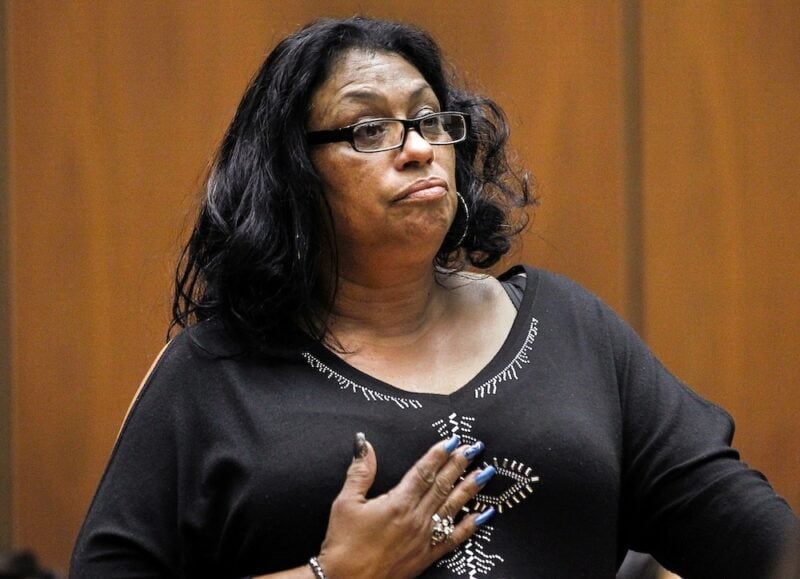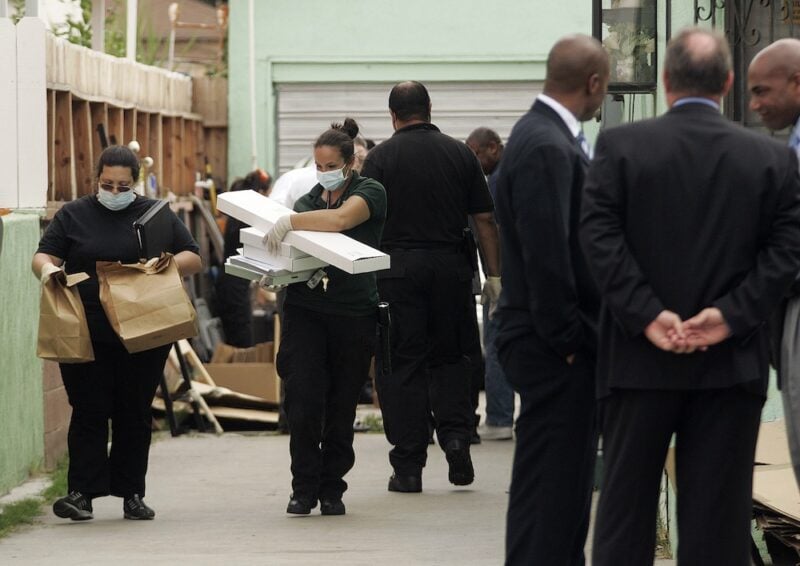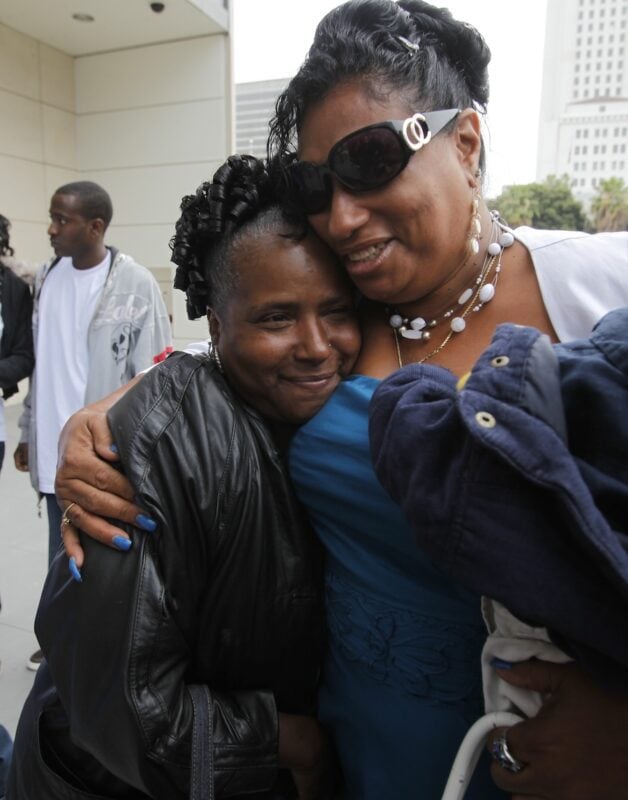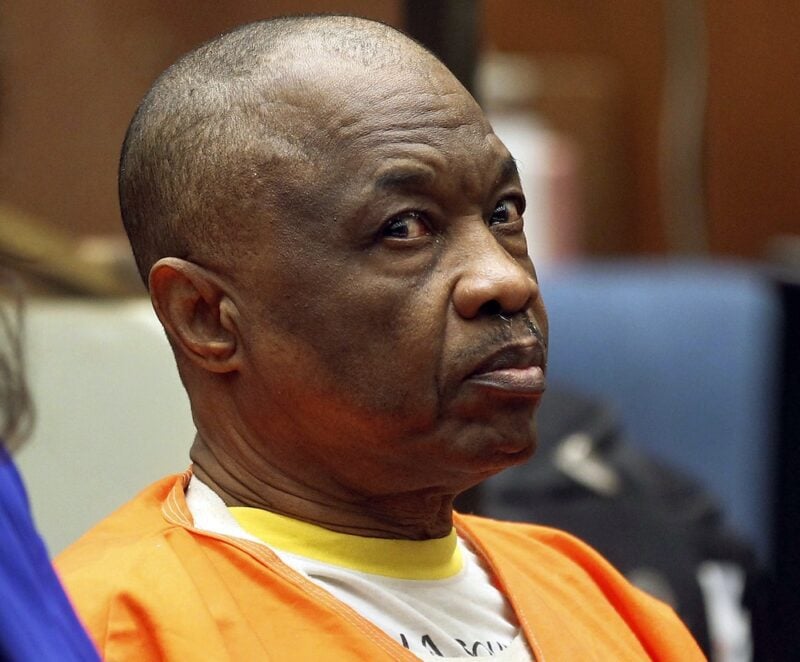Enietra Washington: Only Confirmed Survivor of the Grim Sleeper

Enietra Washington pauses speaking to compose her thoughts as she looks at serial killer Lonnie Franklin Jr. during a preliminary hearing in Los Angeles Superior Court on February 6, 2015. (AP Photo/Nick Ut, File)
Updated August 19, 2024
September 30, 2022 ~ By Shari Rose
Serial killer Lonnie Franklin, known as the Grim Sleeper, murdered at least 10 women & girls in Los Angeles from the 1980s to 2000s. His only confirmed survivor, Enietra Washington, lived on to testify against him
Enietra Washington (Margette) was intended to be the Grim Sleeper’s eighth murder victim the day he watched her walk down the street in South Los Angeles. But against all odds, Washington survived Lonnie Franklin Jr.’s attack in the 1980s, not knowing until the 2000s that she was targeted by a serial killer. Largely due to the LAPD’s indifference to the murders of young Black women in poor neighborhoods, the Grim Sleeper stalked the streets of South LA for decades with little interference from law enforcement. However, as the only confirmed survivor of the Grim Sleeper, Washington’s testimony was critical in finally getting one of the city’s most prolific serial killers off the streets.
- Enietra Washington Meets Lonnie Franklin in South LA
- Washington Survives the Grim Sleeper’s Attack
- Aftermath of the South LA Shooting
- How Lonnie Franklin Became One of LA’s Most Wanted Serial Killers
- LAPD Inaction in Grim Sleeper Case
- Franklin Arrested Through His Son’s DNA Match
- 2016 Trial of the Grim Sleeper in LA
- Why Did It Take Nearly 25 Years for Police to Arrest Franklin?
Enietra Washington Meets Lonnie Franklin in South LA
On the night she crossed paths with the Grim Sleeper, Enietra Washington was a 27-year-old mother of two and lifelong resident of South Los Angeles. On November 19, 1988, she walked a familiar route to her friend Lynda’s house before they were to head to a party together later that evening. While walking, she spotted an orange Pinto with a white racing stripe parked on the side of the street.

A photo of Enietra Washington taken in the 1980s. (Source)
She stopped to admire the unique vehicle when the owner of the car, Lonnie Franklin, noticed her.
“He hollers something,” she said in a 2022 interview with I Survived A Serial Killer. “I kept walking, and he hollered again. And then I turned around and said, ‘I know you’re not hollering at me because if you’re going to talk to me, you have to come to where I am.’”
Washington says that Franklin entered his car and pulled up to her. He was a Black man in his early 30s, wearing a black polo shirt and khakis, and Washington says he appeared non-threatening. He asked her where she was headed, and she answered truthfully. Franklin offered her a ride to her friend’s house, but she declined. Then he threw a line at her that changed her mind: “That’s what’s wrong with you Black women. People can’t be nice to you.”
After hearing this, Washington says she “felt sorry for him,” and agreed to have him drive her to the house.
“Just to prove a point, I was like, since it’ll make you feel better, I’ll let you take me there,” she said.

LAPD mugshot of Lonnie David Franklin Jr., LA’s Grim Sleeper serial killer. (Source)
Once in the Pinto, Washington says the pair enjoyed pleasant conversation. She had no suspicions that anything was amiss, until he told her he needed to make a quick stop. Franklin said he had to stop at his uncle’s house to pick up some money, and then they’d be back on their way to her friend’s house. He drove them to a residential area and entered a nearby home. But when he returned to the car, Washington says his demeanor totally changed.
Franklin became agitated and angry, accusing her of “dogging” him, or disrespecting him. Then he called her by another woman’s name. Confused, Washington turned to face him, then everything went silent. Without warning, he shot her in the chest with a .25 caliber gun.
Washington Survives the Grim Sleeper’s Attack
In the moments after Lonnie Franklin shot her, Enietra Washington says she never heard the gunshot. All she heard was silence.
“He shot me point-blank in my chest,” Washington said in 2022. “But I didn’t realize I’d been shot. I didn’t hear no gun, and I didn’t see blood. But I knew something was really wrong.”
Washington instinctively reached for the door handle to escape, but he said, “Bitch, I’ll shoot you again.”
That’s when the horrifying realization hit her. In shock, she began pleading with Franklin to let her out of the vehicle.
“I was like, ‘Please, just let me out your car,’” she said. “‘Because if I do die, I’m gonna ask the Lord, let me haunt you the rest of your life so that you know that you couldn’t get away with this.’”
The Grim Sleeper continued driving the streets of South LA as Washington felt herself losing consciousness in his car.
- More stories: How Abby Hernandez Convinced Her Kidnapper to Let Her Go
- More stories: Elizabeth Shoaf: ‘Girl in the Bunker’ Saves Herself with a Text
- More stories: How Lisa McVey Survived Abduction by Bobby Joe Long
“I was starting to feel woozy, I was getting weak. I kept fading in and out. And then all of a sudden, I passed out,” she said.
When Washington awoke some hours later, she found herself still in his Pinto, but it was dark outside. She felt pressure on her chest and tried to push it off.
“And then I heard this laugh,” she said. “He was on top of me doing something. I started fighting, but it was like I was paralyzed. And then I let out this long scream. I knew I was gonna die.”
She passed out again. Some time later, she woke up to flashing lights. Washington realized he was taking Polaroid pictures of her.
“I was weak, I just slumped against the seat,” she said. “And then he started driving. I was feeling on the door, I wasn’t even sure what was the door handle, I was hoping it was.”
Eventually, Washington managed to open the car door as the vehicle was moving, and Franklin simultaneously pushed her out onto the street. She landed hard on the asphalt in the middle of the road.
“I was afraid he might drive back. I rolled to the curb, got up, and I saw the blood,” she said.
Despite the serious gunshot wound to her chest, Washington dragged herself to the sidewalk and began walking to find help. She kept walking until she found street signs she recognized. Washington knew she wasn’t far from Lynda’s house, the destination she had been heading toward hours earlier.
In shock and bleeding, Washington stumbled to her friend’s home and pounded on the front door. But no one answered because Lynda had already left for the party. She laid down on the porch and waited for her friend to arrive. Sometime in the night, Lynda returned home and called an ambulance.
Aftermath of the South LA Shooting
Washington was rushed to Harbor-UCLA Medical Center in Torrance. The single bullet had collapsed one of her lungs, and the 27-year-old spent a total of three weeks in the hospital. Despite the point-blank shot, her ribs and sternum mercifully deflected the bullet. It missed her internal organs entirely.
While recovering in the hospital, Washington learned that Franklin sexually assaulted her after she lost consciousness that night.
“I had been raped, but I didn’t remember anything,” she said in an interview on I Survived A Serial Killer.
As she recuperated, Washington tried to piece together why this man would shoot her in an apparently random attack. She also feared he may try to kill her again.
“Now I’m really worried ‘cause I didn’t know where he was or who he was,” she said. “How do I know he’s not going to come after me?”
A couple days after the attack in South LA, detectives from the Los Angeles Police Department visited her in the hospital. She gave a statement and described Lonnie Franklin’s physical appearance to a sketch artist. However, Washington said the LAPD detectives suggested she was a sex worker in an attempt to explain why she would get into his car. She says she fought that allegation, and was furious with the suggestion.
After the bullet was removed from Washington’s chest, police linked it to a .25 caliber gun that had been used in other cold cases in South Los Angeles. The LAPD knew they were dealing with a serial killer by the time of Enietra Washington’s attack in 1988, but kept that information a secret from her and the wider public. In fact, the LAPD refused to even publicly acknowledge a serial killer was targeting Black women in South LA until 2008. This omission essentially provided Lonnie Franklin with free rein to kill whomever he wanted as the Grim Sleeper, largely unimpeded by the Los Angeles Police Department for decades.
- More stories: How Tiffany Taylor Survived Khalil Wheeler-Weaver
- More stories: Kathy Kleiner & Karen Chandler: Ted Bundy Survivors at Chi Omega
- More stories: Kara Robinson’s Escape From a Serial Killer
How Lonnie Franklin Became One of LA’s Most Wanted Serial Killers
Like Enietra Washington, Lonnie Franklin Jr. was born and raised in South Los Angeles. In the 1970s, he joined the Army and was stationed in Germany. In 1975, he received a dishonorable discharge after being convicted of gang raping a 17-year-old girl with two other soldiers. He served less than one year in prison for the attack.
Throughout the 1980s and 1990s, Franklin worked as a trash collector for the city and was even hired as a mechanic for the LAPD. He married a woman named Sylvia, and they had two children together.
Franklin’s first confirmed murder victim was a 29-year-old woman named Debra Jackson, whom he killed on August 10, 1985. Authorities now believe he killed a 21-year-old woman named Sharon Dismuke one year earlier, but they did not have enough evidence to formally charge him in her murder.
By the time Franklin crossed paths with Washington, he had already murdered at least 7 other Black women in South LA. During this period in Los Angeles, a crack epidemic was raging in the city. Neither the police nor local media paid much attention to the killings of young Black women in those poor neighborhoods. Many of the Grim Sleeper’s victims were believed to be sex workers and drug users, which contributed to the relative indifference with which their murders were treated.

Items are removed from the South Los Angeles home of Lonnie Franklin Jr. on July 7, 2010 after his arrest. Pool photo by Gary Friedman. (Gary Friedman/Los Angeles Times)
Despite the ever-growing body count of young women found murdered with the same weapon and dumped in alleys, dumpsters, and streets, their deaths barely made local news. The murders quickly became cold cases, and the LAPD failed to form an investigative taskforce, or even seemingly make any effort to find the killer.
In 1989, an anonymous whistleblower leaked to local media outlets that the ongoing killings of Black women in South LA were the work of a serial killer. However, the LAPD refused to publicly admit a serial killer was responsible and did not warn residents of the dangers facing Black women in particular. As a result, Lonnie Franklin had greater ability to target and kill more victims without arousing suspicion from locals.
LAPD Inaction in Grim Sleeper Case
Every single one of Lonnie Franklin’s victims was killed with the same weapon, a .25 caliber gun. Their bodies were discovered in South Los Angeles neighborhoods, and they were all shot in the chest. Furthermore the victims were all young Black women. Despite the exceedingly obvious facts that a serial killer was responsible for at least 7 murders and Washington’s attempted killing throughout the 1980s, the LAPD kept that information a secret from the public and victim’s families.
Thirteen years after Washington’s attack and subsequent survival, the LAPD started sifting through a massive backlog of unsolved murders from the 1980s and 1990s. Over the next few years, they began connecting evidence from killings that involved the same weapon. Eventually, police discovered evidence found at the scene of a South LA murder from 2002 matched that of an unsolved murder from the 1980s.
In 2006, Enietra Washington was approached by two LAPD detectives. Finally, she learned the truth that she had survived an attack from a serial killer, albeit 18 years later. Later that same year, the LAPD connected the Grim Sleeper’s DNA to two Los Angeles murders committed in 2002 and 2003.
- More stories: When Cindy Paulson Survived Serial Killer Robert Hansen
- More stories: Jennifer Schuett: A Survivor’s 19-Year Journey to Justice
- More stories: How Mary Vincent Survived Lawrence Singleton
Decades after his first killing, Franklin was still operating in South LA and attacking women in the early 2000s. Even still, the LAPD refused to inform the public that a serial killer was stalking and killing women in their neighborhood.
In 2007, the LAPD quietly formed a task force for finding the serial killer. But, police failed to inform families of victims that their loved ones were murdered by the same serial killer from decades earlier. The task force, called 800 Task Force, remained a secret. Earlier in the year, the Grim Sleeper claimed another victim, a 25-year-old Black woman named Janecia Peters, who was found dead on January 1, 2007.

Photographs of some victims found in the possession of Lonnie David Franklin Jr. are featured during a news conference in Los Angeles on December 16, 2010. (AP Photo/Jae C. Hong)
However, journalists from LA Weekly, an alternative newspaper based in the city, learned about the undisclosed task force. In winter 2007, LA Weekly broke the story that a serial killer in South LA had been committing murders since the 1980s. The story also confirmed that the LAPD failed to inform the public, and police still had no suspect. The paper dubbed the unknown serial killer as the Grim Sleeper, because it appeared he stopped attacking women throughout the 1990s. However, authorities now believe Lonnie Franklin may have killed more victims during that period, but their bodies were never recovered.
Families of the Grim Sleeper’s murder victims learned their loved ones were killed by a serial killer through LA Weekly’s article. Most families were never informed by the LAPD, and instead learned the true fate of their deceased daughters and sisters through the journalists covering the case.
In September 2008, the LAPD finally acknowledged these murders were due to a serial killer, and offered $500,000 reward money for information to catch the Grim Sleeper. Major media outlets picked up the story, and it became national news.
In February 2009, Los Angeles Police Chief William Bratton spoke publicly about the serial killer. This was the first time an LAPD police chief publicly acknowledged this serial killer was on the loose in the city, 24 years after Franklin’s first confirmed killing.
Franklin Arrested Through His Son’s DNA Match
By 2009, Los Angeles police still did not have a suspect in the Grim Sleeper case. But the department caught a break when Franklin’s 28-year-old son, Christopher, was convicted on a weapons charge. The LAPD discovered a familial match from Christopher’s DNA was connected to evidence found at the past crime scenes. Detectives then focused on Lonnie Franklin as a potential suspect. They went undercover and collected Franklin’s DNA from utensils he used at a pizza restaurant. It matched the DNA found at the scenes of murders dating back to 1985.
On July 7, 2010, Lonnie Franklin was arrested and charged in the murders of nine women and one teenage girl. He was also charged in the attempted killing of Enietra Washington. Franklin’s arrest came a full 25 years after he committed his first confirmed murder.

Enietra Washington, right, gets a hug by her friend, Romy Lampkins, left, before a press conference held to discuss Franklin’s arrest in Los Angeles on July 8, 2010. (AP Photo/Damian Dovarganes)
At Franklin’s home, investigators uncovered more than 1,000 photos and videos of mostly Black women dating back to the 1980s. Many of the photos were Polaroids of victims who appeared unconscious or dead.
After Franklin’s arrest, Washington says that LAPD detectives paid her a visit. They brought a Polaroid photo they wanted her to examine. It was her 27-year-old self, unconscious and bleeding, slumped over in Franklin’s car in a photo he took the night of her attack 22 years earlier.
- More stories: Teka Adams’ Survival After Fetal Abduction Attempt
- More stories: When Jennifer Morey Survived a Brutal Knife Attack
- More stories: Whitney Bennett: Teenage Survivor of Richard Ramirez
2016 Trial of the Grim Sleeper in LA
Lonnie Franklin Jr. was charged with 10 murders, spanning from 1985 to 2007. Authorities believe he may have killed at least half a dozen other women, but prosecutors did not have enough evidence to charge him. Many of his suspected victims’ bodies have never been found. All of Franklin’s victims were killed with the same weapon, a .25 caliber handgun, and their bodies were discovered throughout South Los Angeles.
Six years after his arrest, the criminal trial of Lonnie Franklin finally began on February 16, 2016. As the Grim Sleeper’s only confirmed survivor, Enietra Washington took the stand to testify against her attempted killer.
“My name is Enietra Margette [Washington], and I’m one of your little pickups,” she said on the witness stand, turning to face him in court. “I really think you are truly a piece of evil. You’re right up there with Manson. The hurting part about it is that you did it to your own. You put my life in fear of people I should be proud of.”

Lonnie Franklin Jr. appears at a court hearing at Los Angeles Superior on February 6, 2015. (AP Photo/Nick Ut)
“It has to be hate, hate for women, your own kind,” she continued. “I don’t have no closure, because I’m still living. It’s a good thing, I pray to God, I thank you every day for it.”
She concluded on the witness stand: “But because you blackmailed me being a Black woman, knowing that I’m supposed to give you respect, and you took it away. So how am I supposed to give that to someone else? So now, you got that yourself, how’s your family supposed to give it to you?”
On May 5, 2016, Lonnie Franklin was found guilty on all counts, 31 years after he killed his first confirmed victim. He was sentenced to death one month later.
In March 2020, Franklin died on death row at San Quentin Prison. Even at the time of this published article, authorities have never released an official cause of death for the notorious Grim Sleeper.
Why Did It Take Nearly 25 Years for Police to Arrest Lonnie Franklin?
Why did it take the police so long to catch the Grim Sleeper? Franklin was not a serial-killing mastermind. He used the exact same weapon in every murder, and attacked women mostly within the same 10-block radius in South Los Angeles. At least six of the victims’ bodies were found within a few blocks of his home. Why did the LAPD refuse to warn residents that a serial killer was targeting young Black women for 23 years, allowing Franklin to stalk and kill victims without awareness from local residents?
The fact is that the Los Angeles Police Department has no good excuse for handling the Grim Sleeper case the way it did. Franklin killed poor Black women whose lives didn’t matter much in the eyes of police or local media. Only after LA Weekly broke the story in 2007 did the LAPD even begrudgingly acknowledge that a serial killer was on the loose, and had been operating unabated for over 20 years.
- More stories: A Hitman Came for Susan Kuhnhausen – He Didn’t Survive
- More stories: How Isaac Wright Jr. Overturned Life Sentence & Became Lawyer
- More stories: How Ellen Halbert Survived a ‘Ninja In The Attic’
In a 2014 documentary called Tales of the Grim Sleeper, Nick Broomfield spoke with Christopher Franklin, Lonnie’s son. Christopher said he had once met with LAPD officers, and many of them asked to shake his hand.
“Some police officers actually admired Lonnie for ‘cleaning up the streets,’” the documentary states. “That seemed, to me, too incredible—that a serial killer could be a person who was respected within certain sections of law enforcement.”
And it wasn’t just one bad police chief that kept the Grim Sleeper a secret from the public and victims’ families. Multiple LAPD police chiefs, including Daryl Gates, Willie Brown, and William Bratton chose to conceal that a known serial killer was targeting Black women in South LA for decades. It’s beyond inexcusable.
But regardless of police inaction, Enietra Washington, who uses the last name Margette today, continues to move on with her life. As the Grim Sleeper’s only confirmed survivor, though a woman named Monica Hunter came forward recently in 2018, Margette says she “feels blessed” to be alive.
“I finally settled down and was able to do things and live life,” she said in 2022. “I really don’t consider myself a survivor because a survivor just survives day-to-day. I am going further. I’m a conqueror.”
- More stories: Read All Survivor Stories at Blurred Bylines







0 Comments